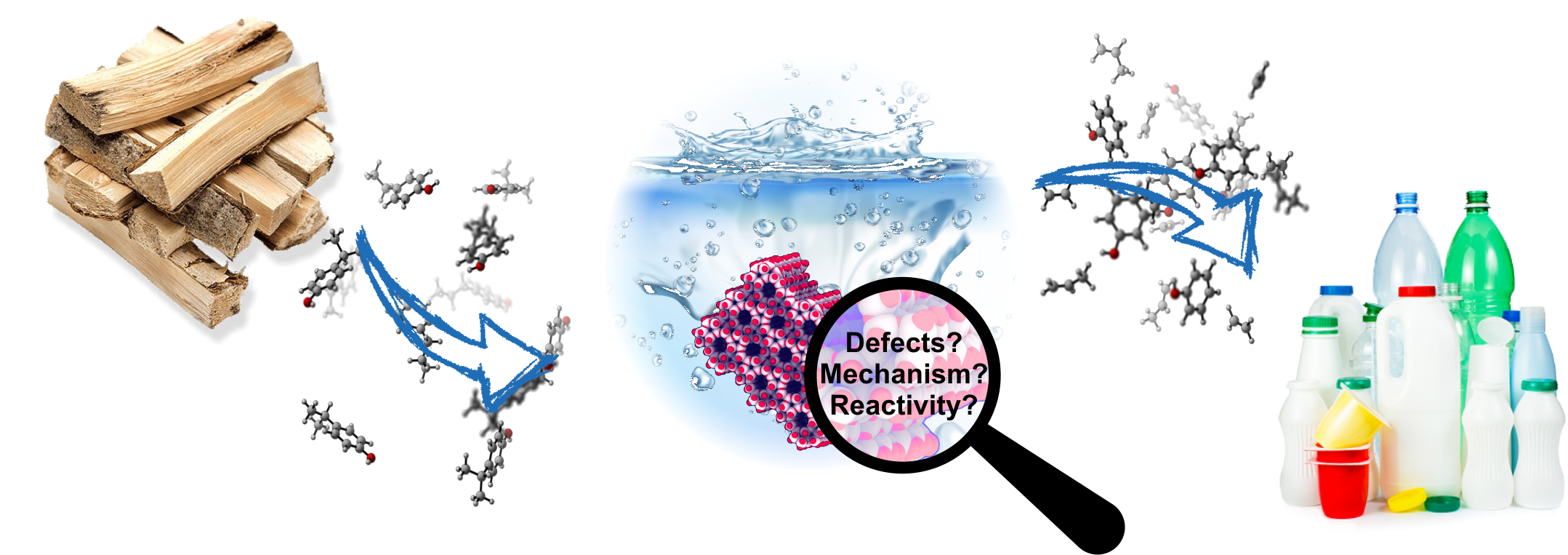The effect of water-induced defects in zeolites on the conversion of biomass-derived alkylphenols
The effect of water-induced defects in zeolites on the conversion of biomass-derived alkylphenols
Promotor(en): V. Van Speybroeck /20NANO04 / Nanoporous materialsProbleemstelling:
The excessive exploitation of crude oil in the past decades has severely reduced the number of easily accessible oilfields around the globe. Despite the possibility to promote a transition towards greener sources of energy, the upcoming shortage of cheap oil will also have a negative impact on the chemical industry. Most carbon-based platform chemicals, such as aromatic monomers for plastic production, are indeed directly obtained from crude oil fractions [1]. For this reason, a lot of effort has been made in the past few years to develop a complete lignin-first biorefinery, to obtain aromatics and other chemicals from renewable biomasses [2]. Together with cellulose and hemicellulose, lignin is one of the main polymeric components of the plant cell walls. In the paper production process, it is removed with aggressive depolymerization techniques and used as low value fuel. This is however a waste of chemical potential, as lignin has the highest content by weight of aromatic units among natural polymers. In the lignin-first approach, on the other hand, lignin is approached as a valuable component of the biomass. New catalysts and innovative processes have been developed to depolymerize lignin with high yield in a mixture of only 4 phenolic monomers, leaving the cellulosic fraction almost unaffected for further usage.
Zeolites are playing a key role in the valorization of lignin-derived compounds, thanks to their ability of withstanding harsh reaction conditions, their micropores-induced selectivity and all the general advantages related to heterogenous catalysts. However, many reactions in lignin conversion would be ideally conducted in hot liquid water (HLW), an environment in which zeolites are known to be generally unstable. This is the case, for instance, of dealkylation reactions applied to lignin-derived alkylphenols, that have already been proved to be possible in pure HLW with a homogenous acid catalyst [3]. Even if new techniques allow to stabilize the zeolite 3-dimensional structure, it is known that water can remarkably change the nature of the active sites, for instance by extracting aluminum atoms from the framework [4-6]. The extent to which such species behaves and interact with the reacting molecules in HLW, possibly completely changing the reaction mechanism and intermediates with respect to “traditional” Brønsted acid sites, is so far not known. Being those effects very difficult to characterize experimentally but critical to understand and optimize the reaction conditions, a theoretical investigation is going to be performed to elucidate the still unknown effects on the active sites of HLW in zeolites (Figure 1).

Figure 1. Schematic representation of the lignin-to-chemicals process, using zeolites in hot liquid water for the intermediate conversion of lignin-derived alkylphenols.
Doelstelling:
The focus of this master thesis is a thorough understanding of the water-induced defects role on dealkylation reactions related to biomass conversion. Considering the harsh conditions at which the reactions are performed (T>200°C, p>50bar) and the mobility of water molecules, the investigation will be performed with state-of-the-art molecular dynamic simulations. You will start by investigating the behavior and stability of various defective sites (regular Brønsted acid sites, water-induced open sites in the framework and extraframework aluminum species) while hot pressurized water is present in the zeolite pores, possibly comparing the behaviour of enclosed water with the pure liquid phase. Subsequently, various lignin-derived molecules (alkyl-substituted catechols and pyrogallols) are going to be introduced in the zeolite and their influence on the water distribution in the catalyst pores will be assessed, together with the defective sites interaction.
You will look for one or more possible dealkylation mechanisms and investigate it with advance sampling techniques. This will allow you to accurately quantify the differences among the various possible defects, in terms of reaction barriers and reaction mechanisms, thus obtaining for the first time a complete overview on how they affect the reactivity of environmentally relevant molecules in zeolites and water.
The Center for Molecular Modeling (CMM) has a large experience in the study of zeolite-catalysed reactions with advanced molecular simulations. You will be coached and guided when needed to become acquainted with the software and techniques required to study the systems of interest. The computational power necessary for the calculations will be ensured by CMM’s access to the main national supercomputing infrastructures. Being the proposed research topic extremely relevant in the contemporary chemistry research the experimental investigations of such reactions is currently ongoing. You will then also have contact with the experimental group of Prof. Bert Sels (KU Leuven), with whom the CMM has a consolidated collaboration.
- Study programmeMaster of Science in Chemical Engineering [EMCHEM]KeywordsHeterogeneous Catalysis, Zeolites, water, Biomass conversionReferences
[1] K. Weissermel and H.-J. Arpe Industrial Organic Chemistry 3rd edition 1997, VCH Publishers.
[2] W. Schutyser, T. Renders, S. Van den Bosch, S.-F. Koelewijn and B. F. Sels Chem. Rev. 2018, 47, 852-908.
[3] J. Bomon, E. Van Den Broeck, M. Bal, Y. Liao, S. Sergeyev, V. Van Speybroeck, B. F. Sels and B. U. W. Maes Angew. Chem. Int. Ed. 2019, 132, 8, 3087-3092.
[4] L. Zhang, K. Chen, B. Chen, J. L. White and D. E. Resasco J. Am. Chem. Soc. 2015, 137, 11810-11819.
[5] M. Nielsen, A. Hafreager, R. Y. Brogaard, K. De Wispelaere, H. Falsig, P. Beato, V. Van Speybroeck and S. Svelle Cat. Sci. Technol. 2019, 9, 3721-3725.
[6] C. J. Heard, L. Grajciar, C. M. Rice, S. M. Pugh, P. Nachtigall, S. E. Ashbrook and R. E. Morris Nat. Comm. 2019, 10, 4690.
